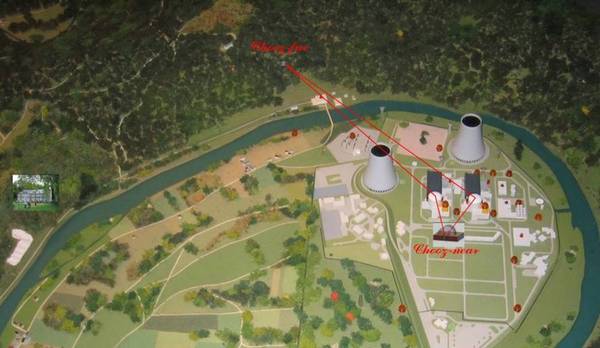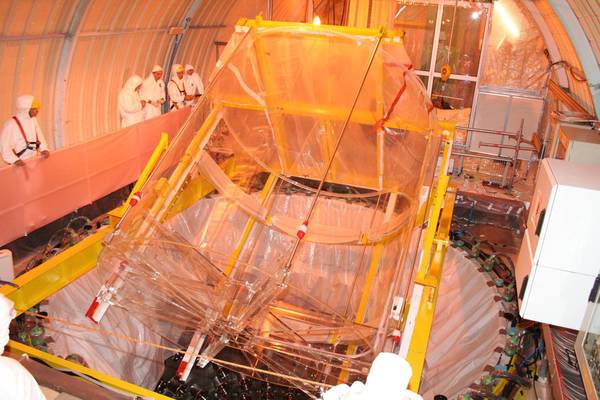Neutrinos: Ghostly Particles with Unstable Egos
06.09.2011 —
Half a century after their discovery neutrinos are still the source of many riddles. The question as to which rules the mysterious particles follow when they alter their identity is one of them. A study in which scientists of the Excellence Cluster Universe at the Technische Universität München also participated has now revealed that even the last of the three parameters, which describe the oscillation of neutrinos is most likely to be greater than zero. The paper will be published in the journal Physical Review D. The new experiment Double-Chooz is intended to further clarify this issue and to pave the way to resolve questions on the origin of matter in the cosmos.
They were always mysterious. 26 years had to pass before the prediction of theoretical physics was confirmed and the existence of neutrinos was finally proven experimentally in 1956. The reason for this ordeal: Neutrinos only interact by the weak interaction with other particles of matter. When a cosmic neutrino approaches the earth, it has the best chance of passing through the whole globe unhindered. It is correspondingly difficult to find direct evidence of neutrinos with the help of a detector. Further decades passed in the discussion about their masses: None or small but finite mass? In the meantime it is considered certain that the ghostly particles are carrying mass, if only a virtually infinitesimal amount: According to today’s knowledge, no neutrino should exist that is heavier than 1 electronvolt (an electron “weighs” about 500,000 electronvolt!). There are three types of neutrinos. This is also believed to be true today, so that neutrinos can each easily be classified in one of the three particle families in the framework of the standard model.
The knowledge of the neutrino mass is based on numerous experiments, in which so-called neutrino oscillations were observed. Neutrinos freely flying through the space of a particular family (i.e. the electron neutrino) can transform themselves spontaneously into a neutrino of another family affiliation (the muon neutrino or tau neutrino). One refers to an oscillation because the neutrino may change its family affiliation periodically during an extended journey. Such oscillations are only possible if the particles are carrying mass. The experimental evidence of neutrino oscillations (and thus a neutrino mass other than zero) is among the greatest breakthroughs of modern particle physics in the past 20 years.
The conversion process among different neutrino flavors depends on three so-called mixing angles theta-12, theta-23 and theta-13 (Θ13). In interplay with the neutrino mass-squared differences they regulate the transition probabilities among different flavors. Of the three mixing angles only two are well known and have large values, while the third one theta-13 is at the focus of current searches. So far, it was known that its value had to be small compared to the other two neutrino mixing angles. That is, theta-13 equalling zero could not be excluded. In the past, several independent projects have tried to measure this elusive parameter without success. The most important piece of information came in 1998 from the Chooz experiment in France, which established that the oscillation evoked by theta-13 cannot be larger than approximately one tenth of those induced by the each of the other two neutrino mixing angles.
Three years ago a group of theoretical physicists of whom one, Antonio Palazzo, is now at the Excellence Cluster Universe, the others at the University and INFN of Bari, evidenced for the first time a weak hint of non-zero theta-13 thanks to an accurate work of global analysis of all the existing neutrino oscillation data [1]. In the meantime, two accelerator experiments (MINOS and T2K) were at work to nailing down theta-13 and they have recently released their results [2,3]. Notably, both experiments point towards a non-zero theta-13, in agreement with the hint evidenced by the group of theorists. By combining their previous findings with the new accelerator data, in June 2011 the same group [4] came for the first time to a statistically clear conclusion according to which sin²Θ13 ≈ 0.02 with a confidence level of at least 3σ (3 sigma). This means that the odds against theta-13 larger than zero are 1:400.
However, physicists are very prudent and, before claiming a discovery, need to have a higher confidence level of 5σ, diminishing the odds against theta-13 larger than zero to 1:1 million. In order to provide secure evidence, the researchers are performing other experiments. Among these, the reactor experiment Double-Chooz [5], in which physicists of the Universe Clusters are strongly involved, will have a crucial role. For this purpose, it has been developed a particularly effective, terrestrial neutrino source: The particles (more precisely: anti-neutrinos) are generated and emitted during the fission processes in a nuclear power plant in particularly high flux. About 1020 antineutrinos leave a typical reactor every second. For this reason, a new experiment, the inheritor of the forerunning Chooz experiment, has started in the vicinity of the nuclear power plant in the French municipality Chooz. Thanks to this setup the value of theta-13 will be measured with a precision that hitherto has not been achieved.
The principle behind the Double-Chooz experiment is very simple: Immediately after their generation in the reactor, several anti-neutrinos collide with a detector located 400 meters away. The spatial proximity ensures that no oscillations (or only extremely few) occur between emission and initial detection. The first detector thus measures the electron anti-neutrinos, which haven’t transformed to muon and or tau neutrinos yet. A second detector of identical construction is located approximately 1,050 meters away from the reactor. If the value of the neutrino mixing angle theta-13 is large enough, a part of the electron anti-neutrinos will become muon or tau anti-neutrinos as a result of the oscillations. The electron-anti-neutrino rate observed at the second detector therefore is much smaller than expected without oscillations.
Both detectors are filled with about 10 tons of scintillation fluid. If an electron-anti-neutrino interacts with a proton within the fluid, this will lead to inverse-beta decay: The proton captures the electron-anti-neutrino thereby transforming into one neutron by emitting one positron. Both particles generate one quick flash each in the liquid in a set time sequence. 390 photo sensors mounted on the walls of the vessel record the events. The Double Chooz experiment started physics data taking in April 2011 and will search for corresponding signals for five years. The detector performance and the status of data taking will be reported at the TAUP conference in Munich from 5 to 9 September 2011. First results are expected by the end of this year.
Establishing that theta-13 is effectively different from zero would entail that all the three mixing angles are non-vanishing. This would provide the three neutrino flavors with maximal freedom of flipping one to each other. In turn, such a high degree of freedom is the necessary condition to generate CP-violation in the leptonic sector, i.e. to give rise to a different behavior of neutrinos and anti-neutrinos. The observation of CP-violation is now the next target of neutrino physicists as it would have significant consequences for several unanswered questions of modern physics. It could soon be clarified, in particular, whether neutrinos were responsible for the minimal surplus of matter compared to anti-matter in the early Universe. Without this asymmetry, all matter would have been transformed to radiation shortly after the birth of the Universe. There would be no galaxies, no stars or planets and no one who could measure theta-13.
[1] G.L. Fogli, E. Lisi, A. Marrone, A. Palazzo and A.M. Rotunno, Hints of Θ13 > 0 from global neutrino data analysis, Physical Review Letters 101, 141801 (2008) [arXiv:0806.2649 [hep-ph]].
[2] K. Abe et al. [T2K Collaboration], Indication of Electron Neutrino Appearance from an Accelerator-produced Off-axis Muon Neutrino Beam, Physical Review Letters 107, 041801 (2011) [arXiv:1106.2822 [hep-ex]].
[3] P. Adamson et al. [MINOS Collaboration], Improved search for muon-neutrino to electron-neutrino oscillations in MINOS, arXiv:1108.0015 [hep-ex], submitted to Physical Review Letters.
[4] G.L. Fogli, E. Lisi, A. Marrone, A. Palazzo and A.M. Rotunno, Evidence of Θ13 > 0 from global neutrino data analysis, arXiv:1106.6028 [hep-ph], to appear in Physical Review D.
[5] http://doublechooz.in2p3.fr/
Press contact:
Barbara Wankerl
PR Manager
Excellence Cluster Universe
Technische Universität München
Tel: +49.89.35831-7105
E-mail: barbara.wankerl@universe-cluster.de
www.universe-cluster.de
Scientific contact:
Dr. Antonio Palazzo
Excellence Cluster Universe
Technische Universität München
Tel: +49.89.35831-7162
E-Mail: antonio.palazzo@tum.de
www.universe-cluster.de
Picture gallery and download










